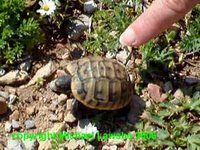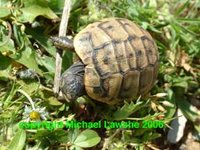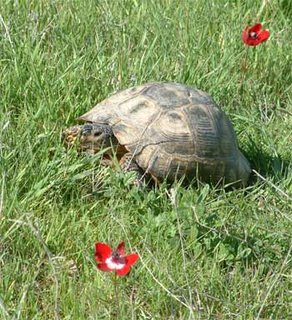In California, our state reptile, the desert tortoise (Gopherus agassizii) is threatened. Its numbers in the wild are declining despite conservation efforts. Even field researchers looking for the dinner-plate-sized adults can wander the desert for hours or even days without spotting an individual. The notion that we would casually see wild tortoises, not once, but several times, during our eight days of traveling the Turkish countryside, never occurred to me.
The first sign that tortoises were about was auditory. One of our fellow travelers heard a thumping knock-knock sound and went to investigate. What he found were two tortoises trying to have a romantic interlude. When a shell covers the majority of your body, physical contact of a serious nature is seldom quiet.

 As we roamed the Aegean region investigating countless Greek, Roman, and Byzantine ruins, we continued to encounter tortoises. The sunny spring days were filled with lush green hillsides and vibrant wildflowers. The undisturbed landscape around the various ancient ruins provided a sanctuary for tortoises. Even though the Turkish people consider it a sign of prosperity to have a tortoise on their property, it is difficult for the herbivorous tortoises to compete with domestic sheep and goats. Abundant domestic chickens can also pose a threat to tortoise eggs and hatchlings.
As we roamed the Aegean region investigating countless Greek, Roman, and Byzantine ruins, we continued to encounter tortoises. The sunny spring days were filled with lush green hillsides and vibrant wildflowers. The undisturbed landscape around the various ancient ruins provided a sanctuary for tortoises. Even though the Turkish people consider it a sign of prosperity to have a tortoise on their property, it is difficult for the herbivorous tortoises to compete with domestic sheep and goats. Abundant domestic chickens can also pose a threat to tortoise eggs and hatchlings.The spur-thighed tortoise (Testudo graeca ibera) is small to medium in size–about the size and shape of a pineapple. The shell is slightly elongated with slight flares around the rear legs. We saw individuals light yellow-green in color to a dark gray-black. This species is quite common in western Turkey and appears in various subspecies throughout the Aegean and Mediterranean. The species in general (Testudo graeca) is also referred to as the Greek tortoise.
One thing was true of all of the spur-thighed tortoises we encountered. They were enjoying spring, either procreating or sampling the lush grasses, clovers, and wildflowers, especially buttercups. In either case, they paid us little mind as we observed and then walked on.
During the 20th century, the spur-thighed tortoise was one of the most popular tortoises in the European pet trade. Countless individuals were collected from the wild and some regional populations were completely depleted. Fortunately this practice was made illegal toward the end of the last century. Combined with the Turkish culture which considers it bad luck to kill a tortoise, legal regulation has helped some populations recover
 .
. In a few areas the tortoises appear to be doing exceedingly well. While exploring an Aegean island and attempting to find a trail to a hillside ruin, we discovered six individual tortoises. They ranged from a breeding pair, to a female digging a hillside nest, to a tiny youngster foraging near the pebbly beach. This little guy was probably last year’s hatchling and experiencing his first spring. He was barely 4 cm (1.5 inches) across.
In a few areas the tortoises appear to be doing exceedingly well. While exploring an Aegean island and attempting to find a trail to a hillside ruin, we discovered six individual tortoises. They ranged from a breeding pair, to a female digging a hillside nest, to a tiny youngster foraging near the pebbly beach. This little guy was probably last year’s hatchling and experiencing his first spring. He was barely 4 cm (1.5 inches) across.Traversing said hillside for less than two hours, going up and down, trying to find a pathway to the ruin, we actually covered only a small area of the shrubby slope. The fact that we saw six tortoises of varying ages was good evidence of a robust island population.

There is something timeless about tortoises. They have an air of ancient wisdom. Their ancestors waded through primordial swamps before the dinosaurs. The fact that they wander now through the ruins of long-gone human civilizations seems appropriate. In many places around the world tortoises are not protected, not honored, and instead are snatched from their homes to appease a misguided human desire to own them. How wonderful it was to see tortoises basking in the sun, trundling through a carpet of wild poppies, and enjoying a wild life in Turkey.
13 comments:
Nice piece! The photos are wonderful. Thanks for enlightening me. Marilyn
What a lovely thing to see, I always think of my tortoises as my own 'prehistoric menagerie'
i was trying to identify my box tortoise what type was it but i think its a female tortoise.. i love the tortoise so much.. i found it when i lost in the woods ...
I have just returned from a trip to Turkey during which I found a tortoise wandering through the ruins of Troy. A delightful experience! I was surprised to find that he had two ticks hitching a ride in the folds of his neck - I doubt that they could have penetrated such a tough hide.
It can be hard to believe but ticks can cause problems for reptiles as well as mammals. Lizards, snakes and tortoises can all become hosts for ticks.
I'm in Ankara (working) at the moment and went for a walk today in the hills by a reservoir there (Eymir Gili). First time I've seen a tortoise in the wild - very special.
once I found two separate tortoises in the zappeion park in Athens. metres from syntagma square
Just saw a tortoise in Marmaris, Turkey!
A friend found a wild tortise in the city of Aydin. Cats are messing with it
Where could he be taken and what would he eat?
The tortoises are still wandering among the ruins and chomping on the flowers in the southern coast of turkey. Was there this spring, 2019. As a Californian worried about our declining tortoises it was so delightful to see so many on each hike into the hillsides on islands and coastal areas. I am so happy to read of the Turkish tradition of treasuring the tortoise and appreciate your comments on the need to leave them to prosper in their native habitat. Thanks for the your informative post.
Mary
😟
We were wandering through the travertine pools and ancient ruins at hieropolis pamukkale today and firstly came across and adult tortoise crossing the path and later the lovely sight of a baby only 40 mm across. A wonderful experience in a wonderful setting.
I always remembered a family holiday in
Turkey. Me and my elder brother were out every morning/ evening checking on a family of tortoises 🐢 in the grass behind a hotel we stayed at ☺️
Post a Comment